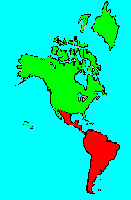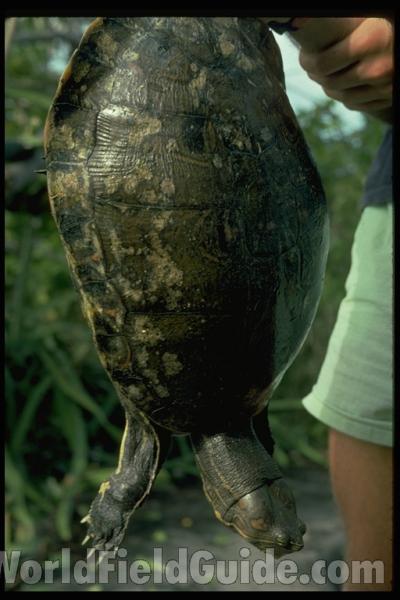SPECIES INFO
Slider (Pseudoemys scripta to Trachemys scripta) can be found from the southern United States as far south as Brazil. There are 14 named subspecies.Slider turtles and cooters, and close relatives (Genus Pseudemys) are native to the New World from Canada south to Florida. The members of this genus have an elongated somewhat domed carapace with sharp serrated edges on the trailing edge.
The Trachemys and Pseudemys genera are easily confused. Barbour counts on a total New World basis six species in the Trachemys genus and five species in the Pseudemys genus.
Emydidae Neotropical are well-represented in the New World tropics with several different slider species, wood turtles, and box turtles are known. Several of them are as follows:
SCIENTIFIC NAME - - - COMMON NAME - - - GENERAL RANGE
Rhinoclemmys annulata - (Brown Wood Turtle) - Central America to Ecuador
Rhinoclemmys areolata - (Furrowed Wood Turtle) - Mexico and Guatemala
Rhinoclemmys funerea - (Black Wood Turtle) - Southern Central America
Rhinoclemmys nasuta - (Large Nose Wood) - Ecuador
Rhinoclemmys punctular - (Spotted Legged) - Venezuela and northern Brazil
Rhinoclemmys melanosterna - (Colombian Wood) - Panama to Ecuador
Rhinoclemmys pulcherrima - (Painted Wood Turtle) - West Central America
Rhinoclemmys rubida - (Mexican Spotted Wood) - Mexico
Terrepane nelsoni - (Spotted Box Turtle) - Western Mexico
Trachemys decussata - (West Indian Slider) - Cuba
Trachemys terrapen - (Jamaican Slider) - Bahamas and Jamaica
Trachemys decorata - (Hispanolia Slider) - Hispanolia
Trachemys scripta - (Pond Slider) - United States to Brazil
Trachemys stejnegeri - (Antillean Slider) - Puerto Rico
Trachemys dorbigni - (Brazilian Slider) - South Brazil
Water and Box Turtle family (Emydidae) is found frequently in North America. Representatives are also found in Europe, South America, and Asia. This group contains most of the familiar freshwater turtles of the world. Ernst and Barbour counted 33 genera with 91 different species.
Turtle and Tortoise group (Order Chelonia) are among the most primitive reptiles. They are egg-laying creatures characterized by having four legs, a tail, and two shells each made up of many scales that are joined together. There are about two hundred and fifty species of turtles in the world. Carl Ernst and Roger Barbour published a book entitled "Turtles of the World" by the Smithsonian Press in l989. This work covers all of the known species. The authors note that there are two hundred and fifty-seven species of living turtles. Many of these species are pictured and discussed here.
The following overview of the various families included in the Turtle Order is based on the aforementioned publication:
SCIENTIFIC NAME - COMMON NAME - NUMBER OF SPECIES
Pelomedusidae - Side Necked - 23 species
Chelidae - Side Necked - 36 species
Kinosternidae - Mud and Musk - 22 species
Dermatemydidae - River Turtle - 1 species
Carettochelyidae - Pig Nose - 1 species
Trionychidae - Soft Shelled - 22 species
Dermochelyidae - Leatherback - 1 species
Cheloniidae - Sea Turtles - 6 species
Chelydridae - Snapping turtles - 2 species
Platysternidae - Big Headed - 1 species
Emydidae - Pond and Box - 91 species
Testudinidae - Tortoises - 50 species
256 total species
While the above counts are currently reliable, they will be impacted by findings as research continues. For example, the exact count of the species of tortoises in the Galapagos and placement of the Florida Snapping Turtle might change these counts.
Reptiles (Class Reptilia) are an ancient group of scaled chordates. These scales may be permanently joined, as in the turtles, or flexible, as in the snakes. Reptiles are land-based. Their eggs are laid on land and the young are air breathing.
In the Great Big Book of Snakes and Reptiles published in 2014, they noted that there are more than 7,000 species of reptiles alive today.
Backboned Animals (Phylum Chordata) are the most advanced group of animals on earth. These animals are characterized by having a spinal cord or backbone. Most members have a clearly defined brain that controls the organism through a spinal cord. Fish, amphibians, reptiles, birds, and mammals are in this phylum.
Currently, some taxonomists believe that the fish should be divided into two groups (sharks and regular fishes) and that there are some other primitive groups in the phylum such as hagfish or lampreys.
Animal Kingdom contains numerous organisms that feed on other animals or plants. Included in the animal kingdom are the lower marine invertebrates such as sponges and corals, the jointed legged animals such as insects and spiders, and the backboned animals such as fish, amphibians, reptiles, birds, and mammals.




